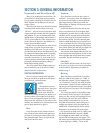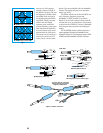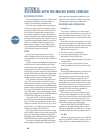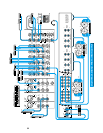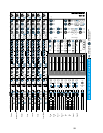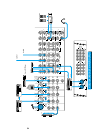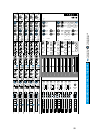
28
Getting reverb into the monitors is a little
more involved, since there is no return assign-
ment switch to MIX-B. You have three choices:
• Assign MIX-B to L/R Mix in the MIX-B master
section. Then, select L/R Mix as your only source
in the monitor section. Finally, use Stereo AUX
Returns 1-6 to bring the reverb into the L/R Mix
buses. Make sure that none of the channel L/R
switches are engaged. There is no disadvantage to
this patch, unless you are already using the L/R
Mix buses for some other function.
• Patch the returns into unused tape returns, using
the Tape In jacks on the rear of the console. Then
route them into MIX-B, just as if they were
additional tape tracks.
• Patch the returns into unused channel strips,
using the Line In jacks. Then you can route
the reverb anywhere your heart desires.
Let’s Record!
Here’s one way to set the board up (another
option is shown in the hook-up drawings…either
works just fine):
Overdub, Anyone?
See the OVERDUB drawings on page 30 and 31.
Once you’ve got your basic tracks down, take
a moment and log all your settings, right down to
headphone sends and outboard compressor
thresholds. You may be back next week doing it
all over again, and you won’t remember it all. It
seems some engineers use a camera for this
step, but our Polaroids never come out that well.
One easy way to do this is to copy the 8•Bus
panel layouts from the end of the manual and
mark your settings on them in color.
Now, normal all the channel inputs and EQs
and sends—anything that does not affect your
MIX-B monitor and cue submix. Do not change
the FLIP switch settings yet.
Then, pick a convenient input channel or two
and use them as your input for overdubs. As you
record on different tracks, just reassign the bus
outputs from the channels, no sweat. Remember,
with the triple busing feature, explained in Sec-
tion 2 (“Submaster/Tape Outputs”), you won’t
have to repatch anything to feed up to a 24-track
recorder. And your monitor mix and cue mix
haven’t changed. At the end of the night, you can
run the monitor mix into a cassette or DAT and
take a rough mix home.
If you’re going to do your final mix right away,
you have another option during overdubbing.
First, pick an input channel for your overdub
mics beyond the number of tape tracks you have.
If you have a 16-Track, choose channels 17 and
18. These will be your inputs, which you will
then assign to open tape tracks for the overdubs.
Now, push the FLIP buttons on channels 1-16.
This will bring the Tape Inputs into the main
channel faders, and you can begin working on
your mix while you monitor on the L/R Bus.
Headphones can still be fed via the AUX Send of
your choice, or by assigning monitor to the
phones. When you’re done overdubbing, your mix
is ready.
MIXING OVERVIEW
See the MIXDOWN drawings on pages 32 and 33.
Recording and overdubbing require care from
the recording engineer, but the focus really has
to be on the performances. It’s important to get a
good sound, but it’s more important to keep the
musicians really in it, keep the pace up, be ready
to snag that killer track when it happens.
Good mixing, however, focuses solely on the
engineer and requires an emphasis on precision
and meticulous setup. Creatively, you must blend
the tracks so they at least sound like music
again; technically, you must take into account
Kick Drum ............to Channel 1 .........Direct Out to Track 1
Snare Drum .......... to Channel 2........... Direct Out to Track 2
Cymbals Left ......... to Channel 3........... Bus 3 to Track 3
Cymbals Right....... to Channel 4........... Bus 4 to Track 4
Tom 1 ..................... to Channel 6........... panned between Buses 3 & 4 to Tracks 3 & 4
Tom 2 ..................... to Channel 7........... panned between Buses 3 & 4 to Tracks 3 & 4
Tom 3 ..................... to Channel 8........... panned between Buses 3 & 4 to Tracks 3 & 4
Bass Amp............... to Channel 9........... Bus 5 to Track 5
Bass Direct ............ to Channel 10 .........Bus 5 to Track 5
Scratch Vocal......... to Channel 11 .........Direct Out to Track 11
Guitar near ........... to Channel 12......... Bus 6 to Track 6
Guitar far .............. to Channel 13......... Bus 6 to Track 6
Piano L .................. to Channel 14......... Bus 7 to Track 7
Piano R .................. to Channel 15......... Bus 8 to Track 8
Trombone I ............ to Channel 16......... panned between Buses 1 & 2 to tracks 9 & 10
Trombone II........... to Channel 17......... panned between Buses 1 & 2 to tracks 9 & 10
Flugelhorn ............. to Channel 18 .........panned between Buses 1 & 2 to tracks 9 & 10
Trumpet ................. to Channel 19......... panned between Buses 1 & 2 to tracks 9 & 10
Your monitoring and cue signals come from
the MIX-B inputs corresponding to the tape
tracks:
Kick .................. Track 1..............Tape Return 1 ............ MIX-B
Snare................ Track 2.............. Tape Return 2............ MIX-B
Drums L........... Track 3..............Tape Return 3 ............ MIX-B
Drums R .......... Track 4..............Tape Return 4 ............ MIX-B
Bass .................. Track 5..............Tape Return 5 ............ MIX-B
Guitar .............. Track 6.............. Tape Return 6............ MIX-B
Piano L ............ Track 7..............Tape Return 7 ............ MIX-B
Piano R ............ Track 8..............Tape Return 8 ............ MIX-B
Horns L ............ Track 9..............Tape Return 9 ............ MIX-B
Horns R............ Track 10............Tape Return 10 .......... MIX-B
Scratch Vocal... Track 11............Tape Return 11 .......... MIX-B
At this point, your recording should pretty
well take care of itself. Keep on top of the play-
ers: be sure they’re in tune, keep them tight.
You’ll have great tracks before midnight.
RECORDING



